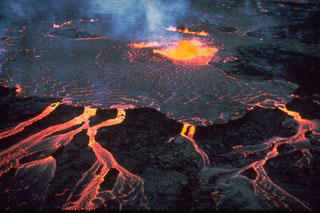Report on Kilauea (United States) — 27 April-3 May 2011
Smithsonian Institution / US Geological Survey
Weekly Volcanic Activity Report, 27 April-3 May 2011
Managing Editor: Sally Sennert.
Please cite this report as:
Global Volcanism Program, 2011. Report on Kilauea (United States) (Sennert, S, ed.). Weekly Volcanic Activity Report, 27 April-3 May 2011. Smithsonian Institution and US Geological Survey.
Kilauea
United States
19.421°N, 155.287°W; summit elev. 1222 m
All times are local (unless otherwise noted)
During 27 April-3 May, HVO reported that the level of Kilauea's summit lava lake fluctuated but remained mostly stable deep in the vent inset within the E wall of Halema'uma'u Crater. A gas plume from the vent drifted SW and deposited very small amounts of ash nearby. At Pu'u 'O'o crater, lava from one or two vent sources continued to fill in a new lava lake in the center of the crater floor. Lava overflowed the edges of the lake, constructing a perched lava lake. During 30 April-1 May the overflows filled the entire crater floor before receding back within the boundaries of the perched lava lake.
Geological Summary. Kilauea overlaps the E flank of the massive Mauna Loa shield volcano in the island of Hawaii. Eruptions are prominent in Polynesian legends; written documentation since 1820 records frequent summit and flank lava flow eruptions interspersed with periods of long-term lava lake activity at Halemaumau crater in the summit caldera until 1924. The 3 x 5 km caldera was formed in several stages about 1,500 years ago and during the 18th century; eruptions have also originated from the lengthy East and Southwest rift zones, which extend to the ocean in both directions. About 90% of the surface of the basaltic shield volcano is formed of lava flows less than about 1,100 years old; 70% of the surface is younger than 600 years. The long-term eruption from the East rift zone between 1983 and 2018 produced lava flows covering more than 100 km2, destroyed hundreds of houses, and added new coastline.
Source: US Geological Survey Hawaiian Volcano Observatory (HVO)

